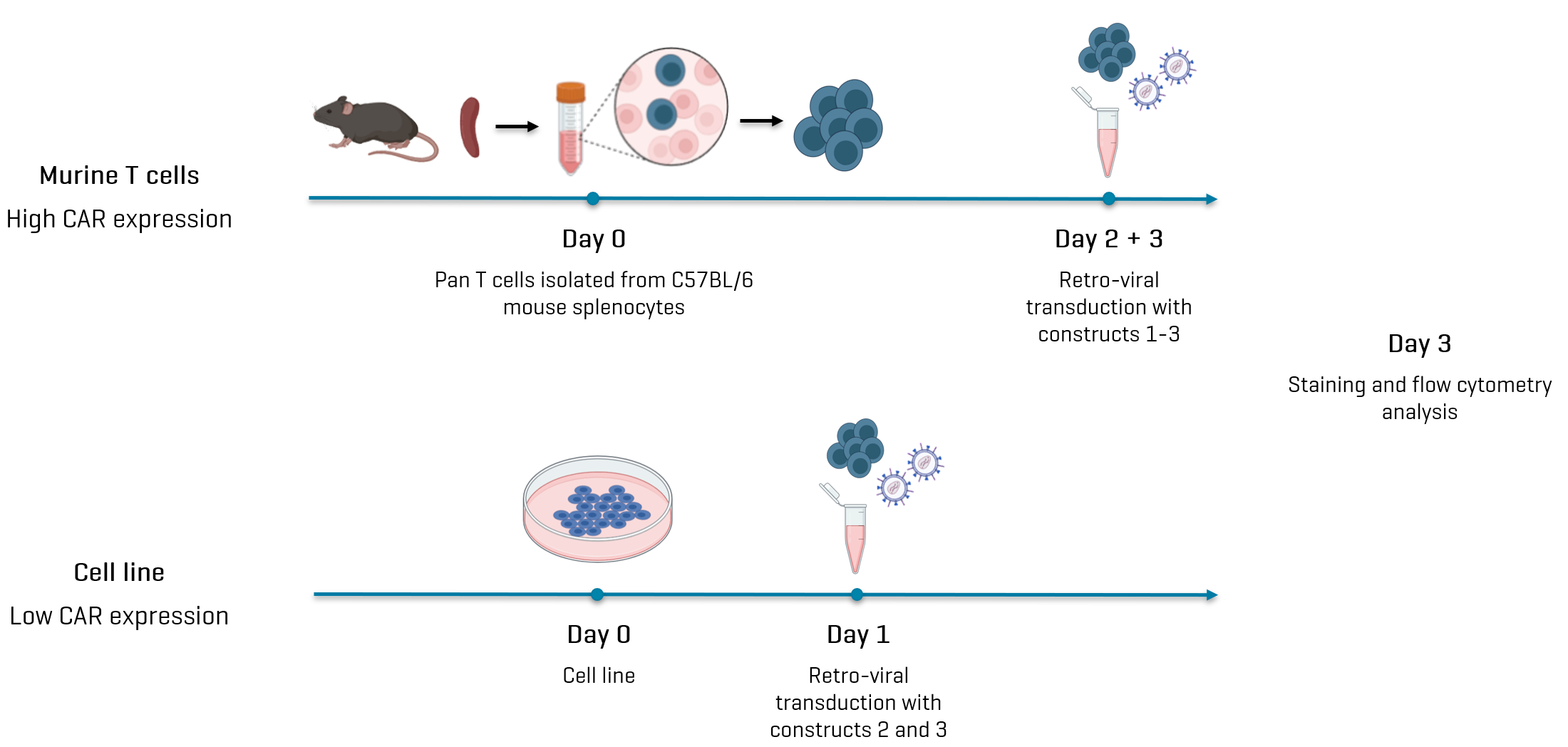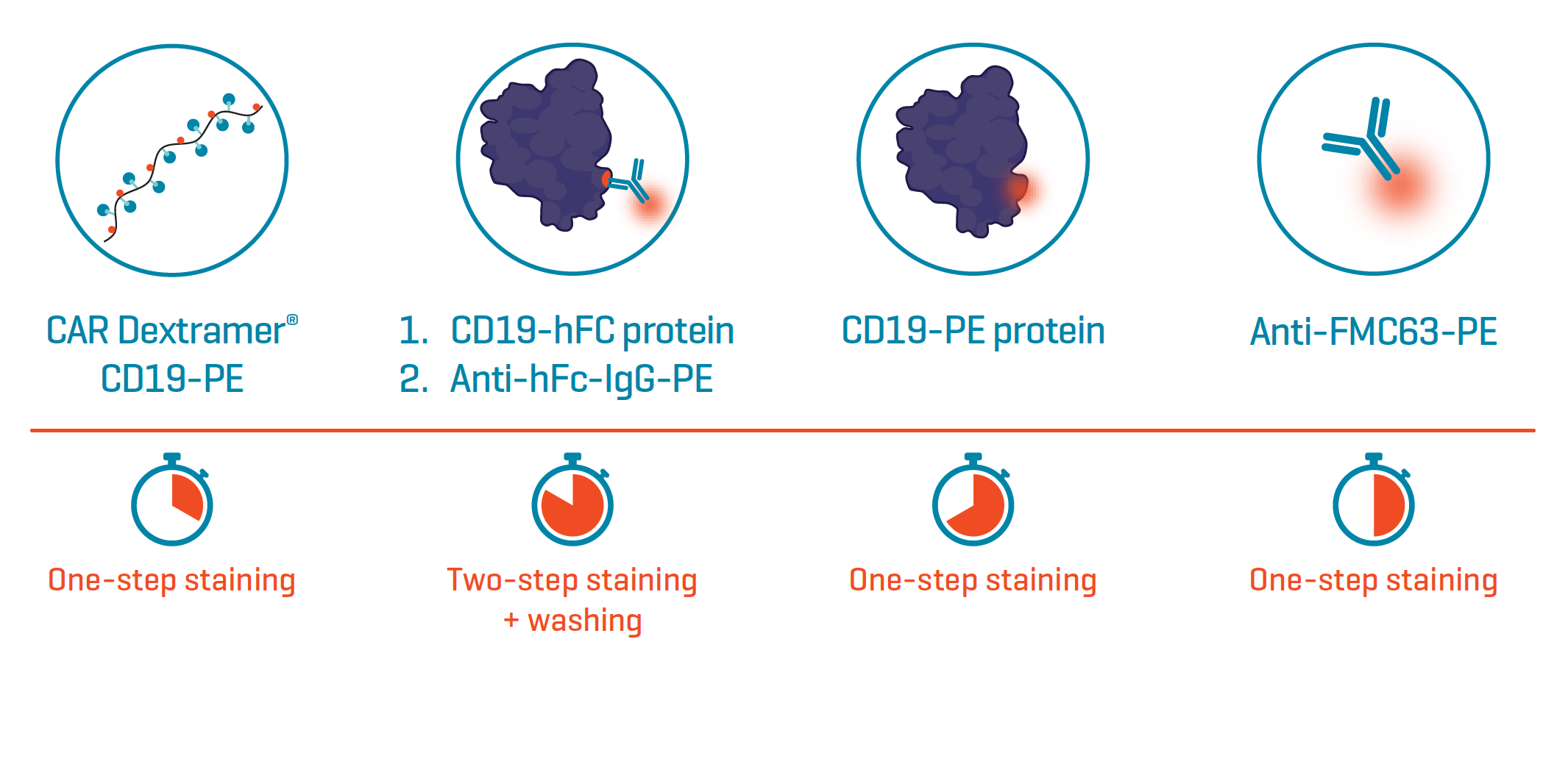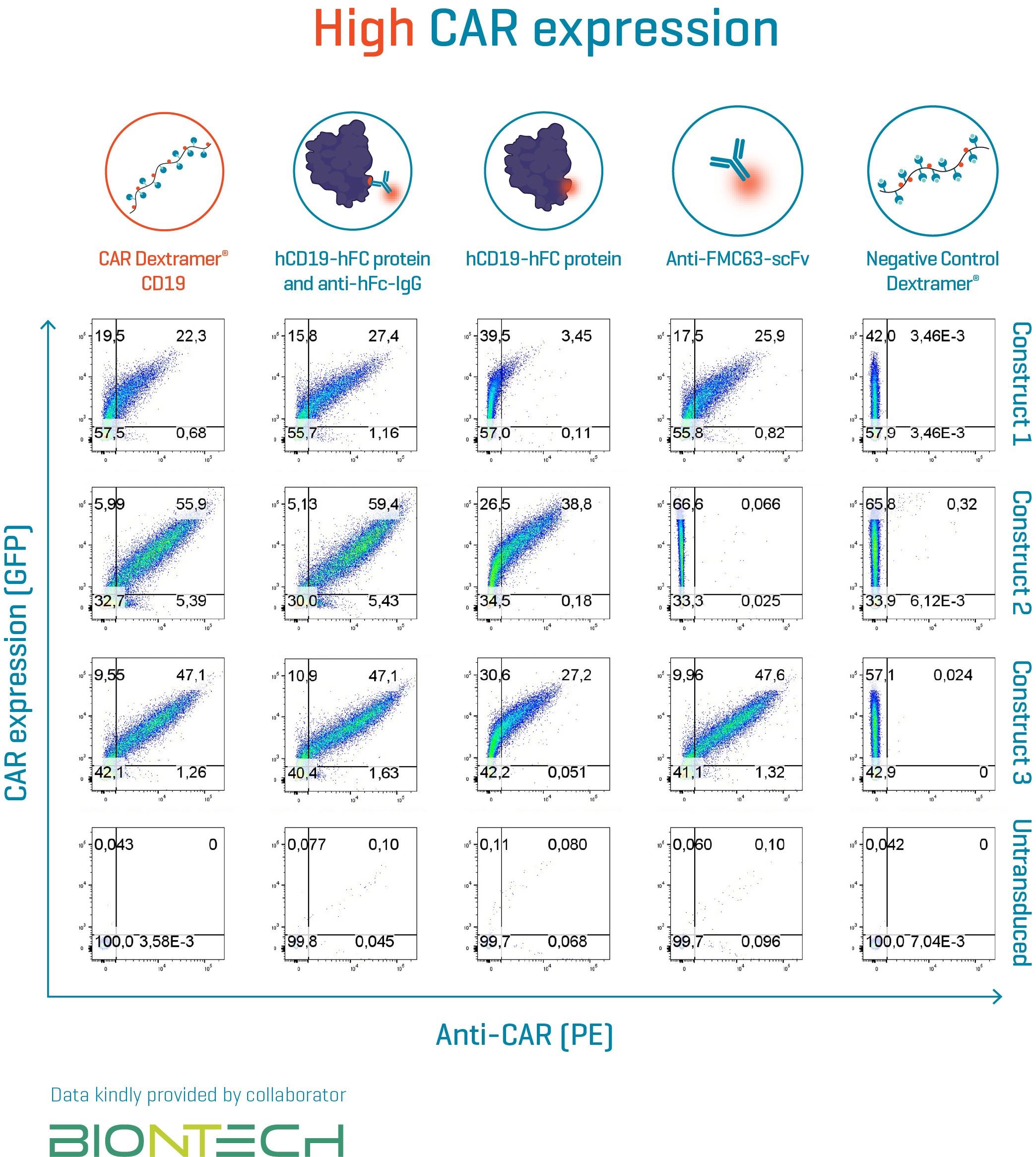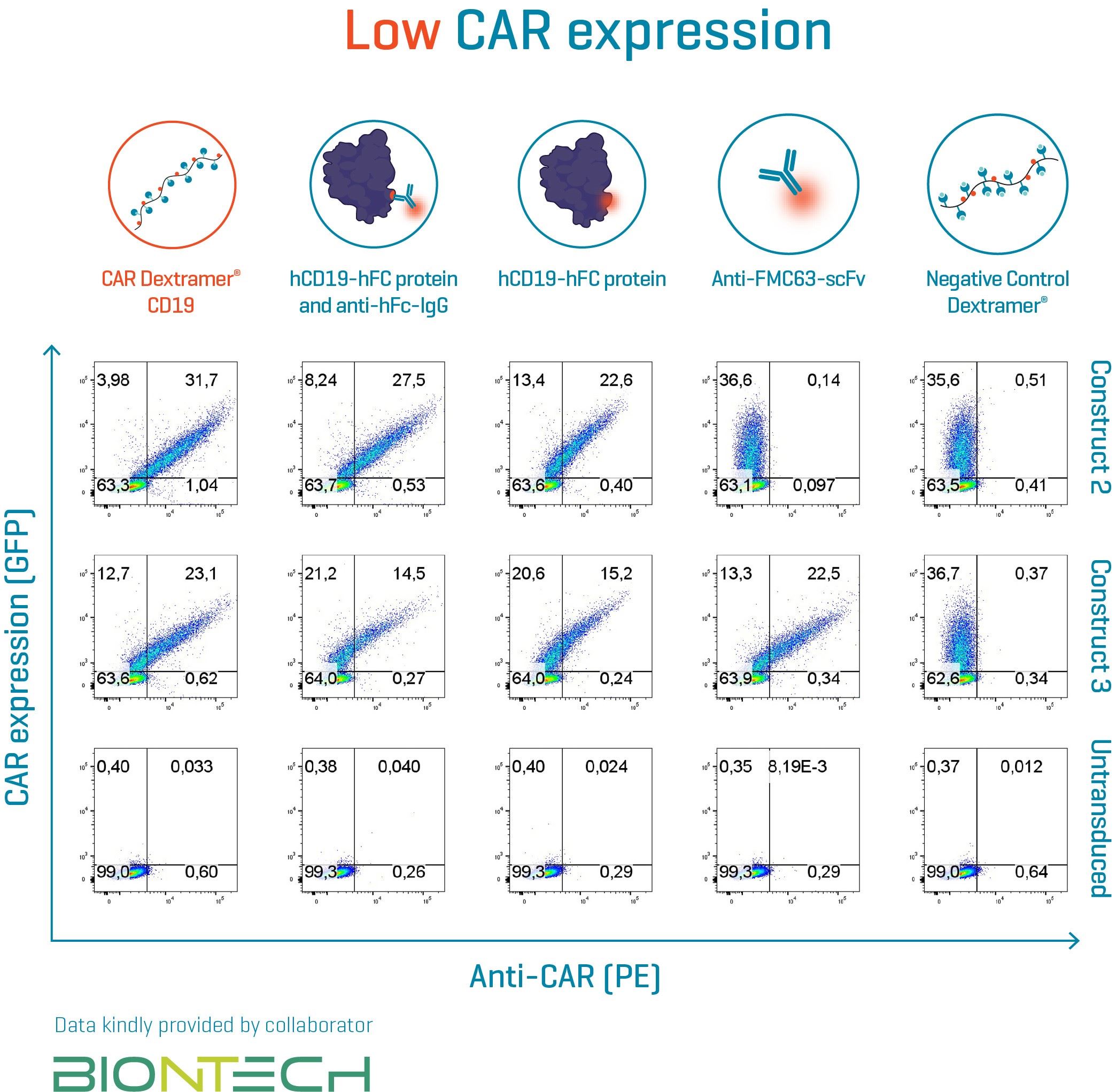- Functional detection: In addition to detection, they provide valuable information about the proper folding and functionality of the engineered receptor.
- Broad use: Offer broader specificity and application. For one, the repertoire of available reagents expands beyond well-established CAR targets like CD19 and BCMA. Secondly, each reagent will detect all CARs targeting a specific antigen easing the exploration of novel CAR constructs.
- Compatibility: they are compatible with flow cytometry panels for more comprehensive immunophenotyping.
- Direct staining: newer reagents are often directly conjugated with fluorophores, paring down staining protocols to a single step.
A Comparison of CAR Detection Reagents
The Proof is in the Staining
The ability to accurately detect and monitor CAR-engineered cells is increasingly relevant as approved CAR-T cell therapies expand in applications and the next generation of constructs tackle diseases beyond blood cancers.
Several reagents are commercially available for the detection of CAR-engineered cells. You can get an overview in our blog post “CAR-T Staining Reagents”. Among those options, antigen-based CAR detection reagents stand out for signaling the presence of a CAR based on its binding of a target antigen. Thus, these reagents detect CAR expression on a cell’s surface while also functionally confirming that the CAR can recognize its intended target.¹
Users of common antigen-based CAR detection reagents, like antigen-Fc chimeric proteins or fluorescently labeled antigen proteins, make note of their limited sensitivity. As the detection level is directly correlated with the availability of surface CAR molecules, low CAR expression might deliver a weak signal that is difficult to distinguish from background noise.
In this blog post, we present data collected by BioNTech, a collaborator interested in testing the performance of different CAR detection reagents.
Setting the Stage for a Fair Comparison
To assess the role of expression level on the signal strength of CAR detection reagents, our collaborator used cells with low and high CAR expression. The cells with high CAR expression were murine cells isolated from spleenocytes and retrovirally transduced to express one of three CAR constructs. All three constructs featured a CD19 CAR and a green fluorescent protein (GFP) reporter protein. Two of the CAR constructs (constructs 1 and 3) contained the anti-CD19 scFv FMC63. Construct 2 featured an alternative anti-CD19 scFv. The low-expressing cells were generated from a cell line transduced with one of the constructs bearing FMC63 or with construct 2 (fig. 1).

Figure 1. Generating CD19-transduced cells with high and low expression of different CAR constructs. Three different populations of high-expressing cells were generated from murine cells using three different constructs. Two of those constructs were transduced into a cell line to produce low-expressing cells.
One or two days after transduction, the engineered cells (three high-expressing populations and two low-expressing populations) were stained with each of four commercially available CD19-specific CAR detection reagents: CAR Dextramer® CD19, a CD19-hFC protein with an anti-hFC antibody, a labeled CD19 protein, and a labeled antibody against the CD19-scFv FMC63 (fig. 2). All reagents used PE as the detection fluorophore.

Figure 2. The four commercially available CAR detection reagents compared in this study. The performance of three antigen-based detection reagents and one labeled antibody was evaluated to assess sensitivity in detecting three different CAR constructs. The lineup included direct and indirect detection, as well as uni- and multivalent detection.
Let’s see what they found out.
Strong Detection of High-Expression CAR-Engineered Cells in Half the Time
In detecting the transduced cells with high CAR expression, the CAR Dextramer® CD19 reagent and the CD19-hFC protein with an anti-hFC antibody exhibited high staining intensity and minimal background across all three constructs (fig. 3). They outperformed the PE-labeled CD19 protein, which barely detected construct 1 and returned lower detection rates for constructs 2 and 3. The anti-FMC63 antibody failed to detect construct 2 because the CAR featured a different anti-CD19 scFv.
While comparable in performance with the CD19-hFC protein plus secondary staining via the anti-hFC antibody, staining with the CAR Dextramer® CD19 reagent involved a significantly shorter one-step protocol and fewer washing steps, which minimizes hands-on-time, as well as cell disturbance and loss. Additionally, the available Dextramer® negative control (fig. 3, last column) helped rule out background noise or non-specific binding in the signal.

Figure 3. CAR Dextramer® reagents offer strong detection signals with a shorter and simpler protocol. Comparing the performance of four CAR detection reagents in quantifying the presence of transduced cells with high expression of three CAR constructs. The last column is the results with a Dextramer® negative control (WI03233). CAR Dextramer® CD19 performed as well as alternative reagents in half the time.
When Construct Expression is Low, Sensitivity Must be High
The power of the CAR Dextramer® reagent really comes to light in the context of low CAR expression. CAR Dextramer® CD19 outperformed all tested reagents in detecting the two transduced constructs. In most cases, the other reagents detected fewer cells than quantified with CAR Dextramer® CD19 (fig. 4), demonstrating the high sensitivity of the CAR Dextramer® reagent that results from its multimerization of high-quality hCD19 proteins and fluorochrome molecules.
The anti-FMC63 antibody showed comparably sensitive detection of construct 3, but its specificity for FMC63 prevented it from detecting construct 2. In contrast, as an antigen-based detection tool, CAR Dextramer® detects any CAR specific to the antigen epitope, regardless of construct architecture. Finally, the faster staining protocol and fewer washing steps needed to use the CAR Dextramer® reagent further expand its benefits when working with low-expressing engineered cells.

Figure 4. CAR Dextramer® reagents combine high sensitivity and broad detection of antigen-specific CARs. A comparison of the performance of four CAR detection reagents in quantifying the presence of transduced cells with low expression of two CAR constructs. CAR Dextramer® CD19 detected low-expressing CARs better than the other tested reagents, regardless of construct architecture.
CAR Dextramer® Reagents: Versatile and Easy to Use
Antigen-based CAR detection reagents are a valuable asset in the CAR-T cell therapy monitoring toolkit. Their ability to confirm both CAR expression and target recognition, along with their increasing availability, makes them a popular choice. However, limitations in sensitivity and time-consuming deployment can hamper advances in the assessment and selection of candidate constructs. As the data from this comparative study show, CAR Dextramer® reagents address those hurdles.
Curious to see how CAR Dextramer® reagents can streamline the evaluation of your engineered cells? Working with targets other than CD19?
Let's talk. Our experts can make It happen.
Related Resources
CAR Dextramer® hCD19
Get more details about our off-the-shelf CAR Dextramer® hCD19 reagent.
Custom CAR Dextramer®
Work with our team to match your target antigen with a Custom CAR Dextramer® reagent.
CAR-T Application Brochure
Download an overview of Dextramer® advantages for the detection and analysis of CAR cells.
CAR-T Staining Reagents
Protein L? Linker antibodies? Learn about the pros and cons of other CAR detection reagents.
Interested in CAR Dextramer® Reagents for CAR Cell Detection?
Fill in the form and one of our dedicated specialists will get in touch with you shortly.
References
¹ Schanda, N. et al. 2021. Sensitivity and specificity of CD19-CAR-T cell detection by flow cytometry and PCR. Cells 10: 3208. https://doi.org/10.3390/cells10113208

